When it comes to collecting all the data needed for a complete picture of city housing stocks and plans, there are many impediments and gaps in information gathered. What would it take to compile a full comprehensive housing assessment?
Allison Plyer: We have a really good detailed picture of what exists and what’s to come with affordable housing. But for housing in general we would need a public database of each property in the city and information about those properties: whether or not they’ve had a homestead exemption, or a demolition permit was issued, or some code enforcement infraction. That data should be downloadable so that folks can map it and analyze it. Then everyone would be able to have a better idea of what is happening neighborhood by neighborhood. And it would be easier to analyze the sales market for people who own property but haven’t been able to return to see what’s going on in their neighborhood.
The Bureau of Government Research released a report on housing supply, which has been used by policymakers who want to halt affordable housing construction, as if the complete picture has been created. How does your report address that?
AP: Some decision-makers have said that they will not make any decisions until they have that complete picture, and that could stall decisions for years. Part of why they have called for those kinds of details is because of the report by Bureau of Governmental Research, which really only simply quantified the supply of subsidized rental housing and said that it is larger than it was before the storm. That is true. But of course the supply of homeowner housing is larger than it was before the storm also, especially with all of the Road Home grants. What the BGR report did not do is look at other side of that question, the demand, and they acknowledged that. Our report said, “We can answer that question.”
We looked at their supply data and it was all perfectly valid. When looking at the supply data you look at the number of vouchers and tax credits. Now sometimes individual households can benefit from more than one subsidy, but they assumed each subsidy accounted for each household. We don’t know the numbers on those duplications, but they did state their assumptions on that up front. We checked all that data. There was nothing inaccurate. We also looked at the supply side and found that while supply is very high the demand is almost twice as high.
Is there an opportunity for GNOCDC and BGR to collaborate given their examination of both sides of the equation?
AP: Well, at our launch event, the people from BGR said that their conclusions were consistent with ours except that they looked at supply and only raised questions about demand. I asked them if they would be willing to release a joint statement, and they said they’d have to go back to their president for approval.
What are some of the ways data collection on housing has been poorly managed by the city?
AP: One trap we’ve seen agencies fall into is they’re getting sold software by impressive software vendors who claim that they will make their data do fancy things. Of course, it all ends up being garbage-in and garbage-out. It is not about software, it is about the hard work of human processes in de-duplicating data, cleaning the data, spelling street names right – making sure data entry is accurate. It’s those mundane human processes of figuring what data needs to be straightened out, what needs to be reinforced or what needs emphasized. Government agencies and even nonprofits get entranced with the lure of fancy software. They somehow believe that will fix everything on the data, when it’s the data itself that needs to be better.
So the charge that there is currently too much affordable housing is entirely false?
AP: Yes, the data shows that there is not nearly enough affordable housing, and even if we build all of the units currently in the pipeline we still won’t have enough. If the data showed otherwise we would have declared that. We don’t go into this with a conclusion in mind. We just check to see what the data says, and this is what the data said.

